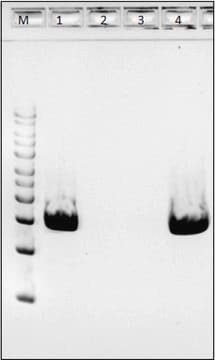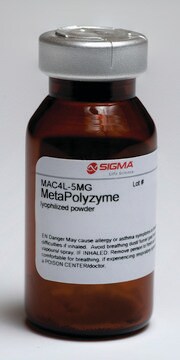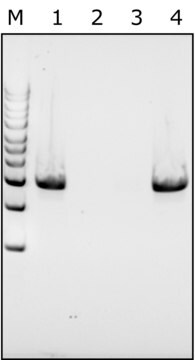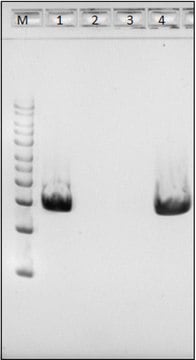A7550
Achromopeptidase from Achromobacter lyticus
lyophilized powder, Protein ~5 % by biuret, 300-600 units/mg solid
Sign Into View Organizational & Contract Pricing
All Photos(1)
About This Item
CAS Number:
MDL number:
UNSPSC Code:
12352204
Recommended Products
form
lyophilized powder
specific activity
300-600 units/mg solid
composition
Protein, ~5% biuret
foreign activity
Collagenase, present
storage temp.
−20°C
Biochem/physiol Actions
Achromopeptidase is a lysyl endopeptidase with a MW of ~27 kDa. It is useful for lysis of Gram-positive bacteria that are resistant to lysozyme.
pH Optimum for activity: pH 8.5 - 9
Approximately 500-1,500 un/ml achromopetidase can be used to lyse cells at a density of OD600=0.6 over 2 hours at 37 °C.
pH Optimum for activity: pH 8.5 - 9
Approximately 500-1,500 un/ml achromopetidase can be used to lyse cells at a density of OD600=0.6 over 2 hours at 37 °C.
Unit Definition
One unit will produce a change in A600 of 0.001 per minute per mL at pH 8.0 at 37 °C using a suspension of Micrococcus lysodeikticus as substrate (1 cm light path).
Physical form
Crude powder containing salts and medium components
Signal Word
Danger
Hazard Statements
Precautionary Statements
Hazard Classifications
Resp. Sens. 1
Storage Class Code
11 - Combustible Solids
WGK
WGK 3
Flash Point(F)
Not applicable
Flash Point(C)
Not applicable
Personal Protective Equipment
dust mask type N95 (US), Eyeshields, Gloves
Certificates of Analysis (COA)
Search for Certificates of Analysis (COA) by entering the products Lot/Batch Number. Lot and Batch Numbers can be found on a product’s label following the words ‘Lot’ or ‘Batch’.
Already Own This Product?
Find documentation for the products that you have recently purchased in the Document Library.
Niamh Toomey et al.
Applied and environmental microbiology, 75(10), 3146-3152 (2009-03-10)
Three wild-type dairy isolates of lactic acid bacteria (LAB) and one Lactococcus lactis control strain were analyzed for their ability to transfer antibiotic resistance determinants (plasmid or transposon located) to two LAB recipients using both in vitro methods and in
Beatrice Quevedo et al.
BMC microbiology, 11, 14-14 (2011-01-21)
The purpose of this study was to design and evaluate fluorescent in situ hybridization (FISH) probes for the single-cell detection and enumeration of lactic acid bacteria, in particular organisms belonging to the major phylogenetic groups and species of oral lactobacilli
Krzysztof Regulski et al.
PloS one, 7(2), e32301-e32301 (2012-03-03)
Peptidoglycan (PG) is the major component of Gram positive bacteria cell wall and is essential for bacterial integrity and shape. Bacteria synthesize PG hydrolases (PGHs) which are able to cleave bonds in their own PG and play major roles in
S Tsunasawa et al.
The Journal of biological chemistry, 264(7), 3832-3839 (1989-03-05)
The complete amino acid sequence of Achromobacter lyticus protease I (EC 3.4.21.50), which specifically hydrolyzes lysyl peptide bonds, has been established. This has been achieved by sequence analysis of the reduced and S-carboxymethylated protease and of peptides obtained by enzymatic
Taro Kishimoto et al.
Proteomics, 11(3), 485-489 (2011-01-27)
Protein termini play important roles in biological processes, but there have been few methods for comprehensive terminal proteomics. We have developed a new method that can identify both the amino and the carboxyl termini of proteins. The method independently uses
Our team of scientists has experience in all areas of research including Life Science, Material Science, Chemical Synthesis, Chromatography, Analytical and many others.
Contact Technical Service









